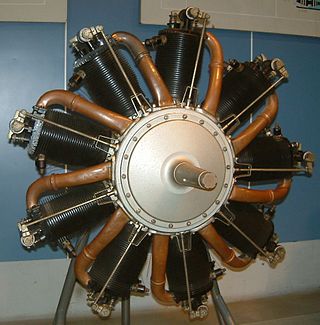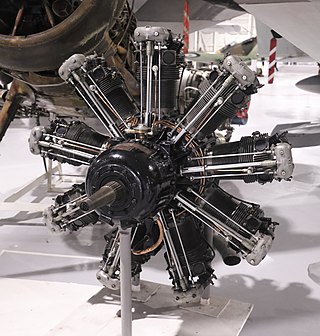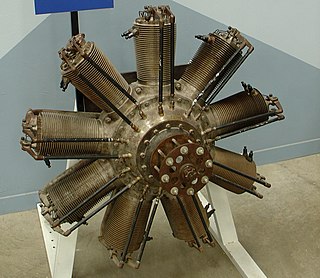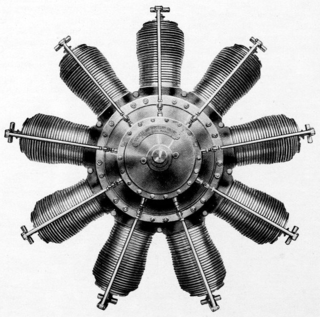Related Research Articles

The rotary engine is an early type of internal combustion engine, usually designed with an odd number of cylinders per row in a radial configuration. The engine's crankshaft remained stationary in operation, while the entire crankcase and its attached cylinders rotated around it as a unit. Its main application was in aviation, although it also saw use in a few early motorcycles and automobiles.

The Bristol Jupiter is a British nine-cylinder single-row piston radial engine that was built by the Bristol Aeroplane Company. Originally designed late in World War I and known as the Cosmos Jupiter, a lengthy series of upgrades and developments turned it into one of the finest engines of its era.

The radial engine is a reciprocating type internal combustion engine configuration in which the cylinders "radiate" outward from a central crankcase like the spokes of a wheel. It resembles a stylized star when viewed from the front, and is called a "star engine" in some other languages.

The Monosoupape, was a rotary engine design first introduced in 1913 by Gnome Engine Company. It used a clever arrangement of internal transfer ports and a single pushrod-operated exhaust valve to replace the many moving parts found on more conventional rotary engines, and made the Monosoupape engines some of the most reliable of the era. British aircraft designer Thomas Sopwith described the Monosoupape as "one of the greatest single advances in aviation".

Clerget was the name given to a series of early rotary aircraft engine types of the World War I era that were designed by Pierre Clerget. Manufactured in France by Clerget-Blin and in Great Britain by Gwynnes Limited they were used on such aircraft as the Sopwith Camel and Vickers Gunbus.

Gnome et Rhône was a major French aircraft engine manufacturer. Between 1914 and 1918 they produced 25,000 of their 9-cylinder Delta and Le Rhône 110 hp (81 kW) rotary designs, while another 75,000 were produced by various licensees. These engines powered the majority of aircraft in the first half of the war, both Allied designs as well as German examples produced by Motorenfabrik Oberursel.

The Rolls-Royce Crecy was a British experimental two-stroke, 90-degree, V12, liquid-cooled aero-engine of 1,593.4 cu.in capacity, featuring sleeve valves and direct petrol injection. Initially intended for a high-speed "sprint" interceptor fighter, the Crecy was later seen as an economical high-altitude long-range powerplant. Developed between 1941 and 1946, it was among the most advanced two-stroke aero-engines ever built. The engine never reached flight trials and the project was cancelled in December 1945, overtaken by the progress of jet engine development.

Le Rhône was the name given to a series of rotary aircraft engines built between 1910 and 1920. Le Rhône series engines were originally sold by the Société des Moteurs Le Rhône and, following a 1914 corporate buyout, by its successor company, Gnome et Rhône. During World War I, more than 22,000 nine cylinder Le Rhône engines were built, with the type far outselling Gnome et Rhône's other main wartime engine series, the Gnome Monosoupape.

The Le Rhône 9J is a nine-cylinder rotary aircraft engine produced in France by Gnome et Rhône. Also known as the Le Rhône 110 hp in a reference to its nominal power rating, the engine was fitted to a number of military aircraft types of the First World War. Le Rhône 9J engines were produced under license in Great Britain by W.H. Allen Son & Company of Bedford, and in Germany by Motorenfabrik Oberursel where it was sold as the Oberursel Ur.II.

The Bentley BR.1 was a British rotary aircraft engine of the First World War. Designed by the motor car engine designer W. O. Bentley, BR.1s powered the majority of Sopwith Camels flown by the Royal Naval Air Service (RNAS).

The Clerget 9B is a nine-cylinder rotary aircraft engine of the World War I era designed by Pierre Clerget. Manufactured in both France and Great Britain, it was used on such aircraft as the Sopwith Camel. The Clerget 9Bf was an increased stroke version.

The Alvis Pelides was an unflown British air-cooled radial aero engine first developed in 1936. The Pelides Major was a projected but unbuilt development as were the Alcides, Alcides Major and the Maeonides Major, the Alvis aircraft engine range taking their names from Greek mythology.

The Gnome 7 Omega is a French seven-cylinder, air-cooled aero engine produced by Gnome et Rhône. It was shown at the Paris Aero Salon held in December 1908 and was first flown in 1909. It was the world's first aviation rotary engine produced in quantity. Its introduction revolutionized the aviation industry and it was used by many early aircraft. It produced 37 kW (50 hp) from its 8 L (490 cu in) engine capacity. A Gnome Omega engine powers the 1912 Blackburn Monoplane, owned and operated by the Shuttleworth Collection, the oldest known airworthy British-designed aeroplane worldwide. A two-row version of the same engine was also produced, known as the Gnome 14 Omega-Omega or Gnome 100 hp. The prototype Omega engine still exists, and is on display at the United States' National Air and Space Museum.

The Gnome 9 Delta was a French designed, nine-cylinder, air-cooled rotary aero engine that was produced under license in Britain. Powering several World War I era aircraft types it produced 100 hp (75 kW) from its capacity of 16 litres (980 cu in).

The Gnome 7 Lambda was a French designed, seven-cylinder, air-cooled rotary aero engine that was produced under license in Britain and Germany. Powering several World War I-era aircraft types it was claimed to produce 80 horsepower (60 kW) from its capacity of 12 litres although recorded figures are lower.
The Gnome 7 Gamma was a French designed, seven-cylinder, air-cooled rotary aero engine. Powering several pre-World War I era aircraft types it produced 70 horsepower (52 kW) from its capacity of 12 litres.
The Clerget 11Eb was an 11-cylinder rotary aircraft engine of the World War I era designed by Pierre Clerget. Powering Sopwith types it was nominally rated at 200 horsepower (150 kW).

The Clerget 7Z was a seven-cylinder rotary aircraft engine of the World War I era designed by Pierre Clerget. First appearing in 1911 it was nominally rated at 80 horsepower (60 kW). 347 examples were jointly built in Britain by Gordon Watney & Co Ltd of Weybridge and Gwynnes Limited of Hammersmith.

The Gnome 7Σ Sigma is a French seven-cylinder, air-cooled rotary aero engine.
The Goupy Type B was a staggered biplane designed by Ambroise Goupy in the early 1910s.
References
- ↑ The Rotary Aero Engine, Andrew Nahum 1987, ISBN 1 900747 12 X, p.40
- ↑ Aviation Engine Examiner, Major Victor W. Page, The Norman W. Henley Publishing Co., 2 West 45th Street, New York 1931, p.146
- ↑ The Rotary Aero Engine, Andrew Nahum 1987, ISBN 1 900747 12 X, p.40
- ↑ I Kept No Diary, Air Commodore F.R. Banks 1978, ISBN 0 9504543 9 7, p.63
- ↑ The Rotary Aero Engine, Andrew Nahum 1987, ISBN 1 900747 12 X, p.27
- ↑ J.S. Hecht; A.T. Dowdell (1921-05-17). "Obturator ring" (PDF). Retrieved 2024-05-20– via patentimages.storage.googleapis.com.